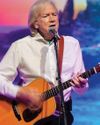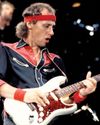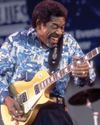
This month we have a superb masterclass with Italian virtuoso Daniele Gottardo. In the accompanying video Daniele provides a detailed explanation of his approach to playing on Jason’s orchestral rock track, The Parade. It features a medium 120bpm tempo with a straight quaver feel, with four main sections to negotiate: verse, chorus, pre-chorus and middle eight.
The chords and harmony are dense and complex so instead of taking an improvised solo Daniele composed one so he could navigate the changes while allowing for dynamics and emotive articulations. Each chord in the verse is tackled individually to ensure that the harmony is perfectly framed. Certainly, no one scale can be used over The Parade as the key centre continually shifts.
An important theme in Daniele’s approach is the use of scale and arpeggio substitutions. This is a great way to access more complex sounds with a fairly standard palette of scales and arpeggios. For instance in the chorus the A Major triad (A-C#-E) is played over the track’s C7 (C-E-G-Bb); the E note is the 3rd of C, the A note is the 13th and the enharmonic equivalent of C# is Db which functions as a b9 in the context of C7. So overall a rich, C13b9 sound is produced.
For the chorus Daniele composed a definite melody that fits in with the ‘cycle of 5ths’ chord progression; a classic movement found in many great songs, from Autumn Leaves to Killing Me Softly, the Theme From Mash to Parisienne Walkways.
Diese Geschichte stammt aus der Spring 2023-Ausgabe von Guitar Techniques.
Starten Sie Ihre 7-tägige kostenlose Testversion von Magzter GOLD, um auf Tausende kuratierte Premium-Storys sowie über 8.000 Zeitschriften und Zeitungen zuzugreifen.
Bereits Abonnent ? Anmelden
Diese Geschichte stammt aus der Spring 2023-Ausgabe von Guitar Techniques.
Starten Sie Ihre 7-tägige kostenlose Testversion von Magzter GOLD, um auf Tausende kuratierte Premium-Storys sowie über 8.000 Zeitschriften und Zeitungen zuzugreifen.
Bereits Abonnent? Anmelden

THE MOODY BLUES
This month Stuart Ryan delves into the picking style of this British prog legend whose acoustic guitar has powered many a Moody Blues song.

WAYNE KRANTZ
This issue Nick Mellor provides an insight into this brilliant jazz stylist, focusing on his approach to improvising over static chords.

OPEN G TUNING
Open tunings are great fun and can help create exciting new ideas. Simon Barnard shows how to incorporate open G tuning into your playing.

RODRIGO GOUVEIA
Last month we featured Mateus Asato, and mentioned the importance of the neo-soul style in his playing. Here we turn to his fellow Brazilian, the master of neo-soul fusion.

MARK KNOPFLER
Our topic this month is a master craftsman as both guitar player and songwriter. His style is unique and his influence spreads far and wide.

U2
Martin Cooper checks out the chiming pedal delay tones of this stadium-filling band from Dublin, Ireland, and guitarist The Edge.

LUTHER ALLISON
It’s blues with a touch of soul this month, as David Gerrish explores the dynamic, expressive style of an often overlooked Chicago bluesman.

JOHANN KASPAR MERTZ Capriccio
This month Declan Zapala explores the music of Austria at the turn of the Romantic period with a fiery caprice to level up your fingers and unlock your inner virtuoso.

THE CROSSROADS Michael Landau
John Wheatcroft explores the playing of a session ace _ and blazing blues-rock maestro who graces the top-flight m band of singer-songwriting legend, James Taylor.

VIDEO MASTERCLASS Troy Redfern
This month GT welcomes this slide guitar virtuoso. If you've been wanting to take your slide playing to the next level then this is one's for you. With Jon Bishop.